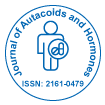Research Article
Do Postmenopausal Women Have Higher Serum 25-Hydroxyvitamin D3 Concentrations Compared to Men or Younger Women?
| Martha A Kaeslin*, Cyril A Fuhrer, Roberto Herklotz and Andreas R Huber | ||
| Institute of Laboratory Medicine, Cantonal Hospital Aarau, Tellstrasse, 5001 Aarau, Switzerland | ||
| Corresponding Author : | Martha A Kaeslin PhD, Institute of Laboratory Medicine Cantonal Hospital Aarau, Tellstrasse 5001 Aarau, Switzerland Tel: +41 62 838 52 90 Fax: +41 62 838 53 99 Email: martha.kaeslinmeyer@ksa.ch |
|
| Received November 18, 2014; Accepted December 08, 2014; Published December 12, 2014 | ||
| Citation: Kaeslin MA, Fuhrer CA, Herklotz R, Huber AR (2014) Do Postmenopausal Women Have Higher Serum 25-Hydroxyvitamin D3 Concentrations Compared to Men or Younger Women? Autacoids 3:107. doi: 10.4172/2161-0479.1000107 | ||
| Copyright: © 2014 Kaeslin MA, et al. This is an open-access article distributed under the terms of the Creative Commons Attribution License, which permits unrestricted use, distribution, and reproduction in any medium, provided the original author and source are credited. | ||
Related article at Pubmed Pubmed  Scholar Google Scholar Google |
||
Abstract
Background: Vitamin D deficiency is a widely discussed topic in medicine. However, the phenomenon that postmenopausal women have higher 25(OH)D3 concentrations compared to men or younger women is rarely described in the scientific literature. Therefore the objective was to investigate this phenomenon in a representative population between different life periods and gender in Aarau (Switzerland) at the end of wintertime when the lowest 25(OH)D3 concentrations can be observed from seasonal cycling. Methods: 25(OH)D3 serum concentrations were measured in a volunteer study population (88 women, 26 men;age: 25-82 years) and we compared all 25(OH)D data of patients of the cantonal Hospital of Aarau in the years from 2010 to 2012(2,766 women, 1,532 men; age: 3 month - 99 years) from the end of February to the end of March 2011. Measurements were performed by HPLC and LC-MS/MS routine assays. Further information was obtained from an especially designed questionnaire. Results: Overall vitamin D deficiency (25(OH)D3<50 nmol/L) was more present in men (≥ 50%) than women(<50%). In the volunteer study population and in the hospital patient population elderly women, especially postmenopausal women, had significantly higher mean 25(OH)D3 concentrations (66.5 and 61.0 nmol/L) compared to men (52.3 and 48.2 nmol/L, P<0.05). Conclusions: At the end of wintertime postmenopausal women had the highest 25(OH)D3 serum concentrations compared to younger females and any age cohort of men. Therefore increased testing should be performed for younger women and men to prevent vitamin D deficiency especially during wintertime.

 Spanish
Spanish  Chinese
Chinese  Russian
Russian  German
German  French
French  Japanese
Japanese  Portuguese
Portuguese  Hindi
Hindi